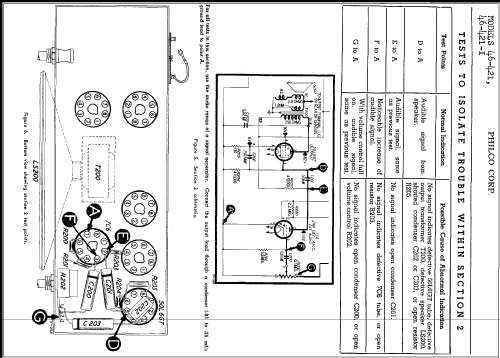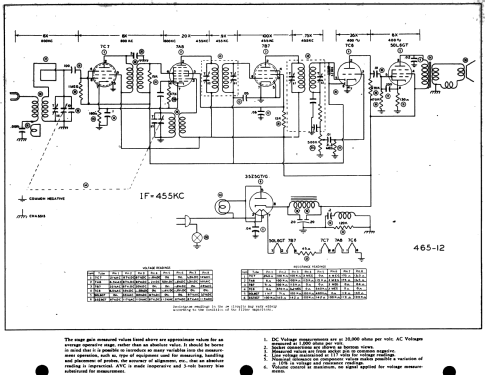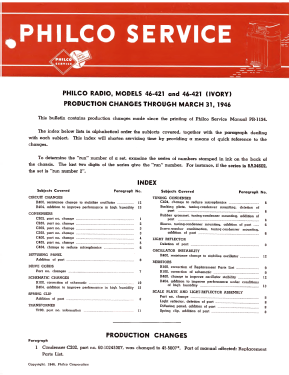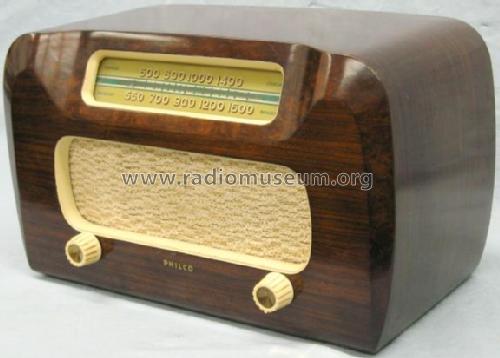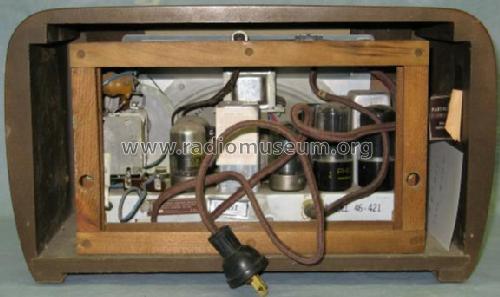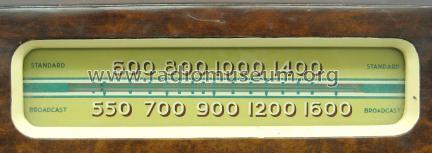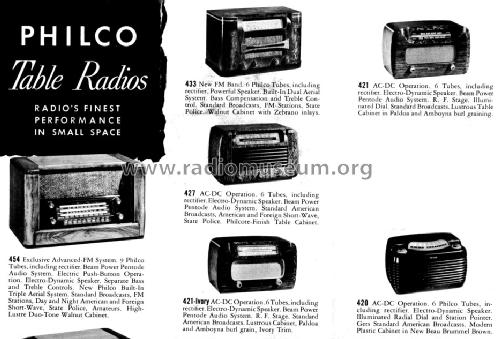- Country
- United States of America (USA)
- Manufacturer / Brand
- Philco, Philadelphia Stg. Batt. Co.; USA
- Year
- 1946
- Category
- Broadcast Receiver - or past WW2 Tuner
- Radiomuseum.org ID
- 50871
Click on the schematic thumbnail to request the schematic as a free document.
- Number of Tubes
- 6
- Main principle
- Superhet with RF-stage; ZF/IF 455 kHz; 2 AF stage(s)
- Tuned circuits
- 7 AM circuit(s)
- Wave bands
- Broadcast only (MW).
- Power type and voltage
- AC/DC-set / 115 Volt
- Loudspeaker
- Electro Magnetic Dynamic LS (moving-coil with field excitation coil)
- Material
- Wooden case
- from Radiomuseum.org
- Model: 46-421 - Philco, Philadelphia Stg. Batt
- Shape
- Tablemodel, low profile (big size).
- Notes
-
Elliptical speaker 4" × 6". Sams photofact folder 465-12 date 10-46 features the Philco models 46-421 and 46-421-1 as the same schematic.
- External source of data
- Ernst Erb
- Source of data
- Collector's Guide to Antique Radios 4. Edition
- Circuit diagram reference
- Rider's Perpetual, Volume 19 = 1949 and before
- Mentioned in
- A Flick of the Switch 1930-1950
- Literature/Schematics (1)
- Photofact Folder, Howard W. SAMS (Folder 465-12 date 10-46)
- Literature/Schematics (2)
- Machine Age to Jet Age II (page 218.)
- Literature/Schematics (3)
- Philco Folder for 1946.
- Other Models
-
Here you find 4086 models, 2222 with images and 3734 with schematics for wireless sets etc. In French: TSF for Télégraphie sans fil.
All listed radios etc. from Philco, Philadelphia Stg. Batt. Co.; USA
Collections
The model 46-421 is part of the collections of the following members.
Forum contributions about this model: Philco, Philadelphia: 46-421
Threads: 1 | Posts: 1
How to make a Philco “Special” capacitor.
Philco uses a Special Capacitor that has an inductive series coil added. Philco also uses a special capacitor that has highly inductive qualities engineered in. It is designed to bypass IF to chassis ground. This Philco 46-421 uses one of these as C401. I had to fabricate a replacement. This is how I did it.
To build the coil:
- First acquired a new polypropylene capacitor of 0.2uf 630volts. The high voltage is what I had in stock.
- Use enamel covered magnetic wire. First soldered one end of the wire to one capacitor lead and clipped it short.
- Lay the wire up the middle of the capacitor lengthwise and wrap the coil over top of the magnet wire lead. This holds the wire from slipping.
- Wrap about a 1cm long coil around the out side of the new capacitor.
- Secure the loose coil in place with sticky tape.
To adjust the coil:
- Connect a 1 or 2 ohm resistor to the free capacitor lead wire. This resistor will generate a voltage to be measured by the oscilloscope.
- Connect the ground lead of the o-scope and signal generator to the loose end of the resistor.
- Connect the o-scope probe to the junction of the resistor and capacitor.
- Connect the signal generator to the loose end of the new coil.
- Set the signal generator for 455 kHz IF frequency.
Adjust the o-scope to display the signal and set an amplitude reference point. The o-scope has a percentage graticule. I set the amplitude for 100%.
Then raised and lowered the frequency. Added or remove coil windings until the signal decreased on either side of 455kHz.
Checked the top end and bottom end frequency at 90% attenuation. Once satisfied with the response replace the sticky tape with heat shrink tubing.
I tried a UL rated safety capacitor with a smaller value but birdies (harmonic interference) appeared across the band. I remade the filter with the original capacitance of 0.2 uf and all the birdies were gone.
Other reference reading can be found on the “Philco Repair Bench” web site. It has a great functional description of Philco’s Special Capacitors.
Happy Fabricating,
Paul
Paul E. Pinyot † 2013, 21.Jan.11



